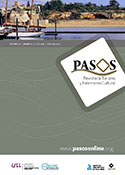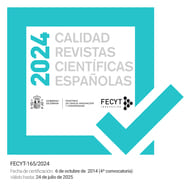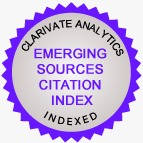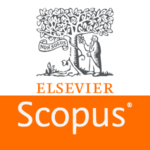Turismo inducido por el cine: Una segmentación de clases latente basada en la satisfacción y las intenciones futuras
DOI:
https://doi.org/10.25145/j.pasos.2016.14.057Keywords:
film-induced tourism, satisfaction, loyalty, segmentation, latent class cluster analysisAbstract
Film tourism has emerged as a driver of tourism development for many destinations. The objective of this research is to evaluate the effects of a film tour on the: (1) relative size of various clusters of visitors; (2) overall satisfaction; (3) intentions to revisit the destination; and (4) intentions to recommend it. The results obtained from a survey of 226 visitors indicate that the size of the three clusters identified varied significantly as a result of the film tour’s promotional campaign, while overall satisfaction with the destination and intentions to recommend it decreased. The study contributes towards bridging gaps in the research in the area of film-induced tourism since it proposes a segmentation based on visitors’ satisfaction and their loyalty intentions. This research provides recommendations to promoters of the film tour considered and the destination marketing organizations.
Downloads
Publication Facts
Reviewer profiles N/A
Author statements
- Academic society
- PASOS. Revista de Turismo y Patrimonio Cultural
- Publisher
- Instituto Universitario de Investigación Social y Turismo. Universidad de La Laguna (España) - Instituto Universitario da Maia ISMAI (Portugal)
References
Alén, M.E., Rodríguez, L. and Fraiz, J.A. 2007. “Assessing tourist behavioral intentions through perceived service quality and customer satisfaction”. Journal of Business Research, 60(2): 153-160.
Araújo, N. 2015. “De la economía de experiencias al turismo experiencial. Las series de ficción como creadoras de experiencias e inductoras a la visita de destinos turísticos”. Pasos: Revista de Turismo y Patrimonio Cultural, 13(4): 959-964.
Araújo, N. and Fraiz, J.A. 2013. “Las series audiovisuales como herramienta promocional de un destino turístico: el caso de España”. Investigaciones Europeas de Dirección y Economía de la Empresa, 19(1): 8-15.
Bandyopadhyay, R. 2008. “Nostalgia, identity and tourism: Bollywood in the Indian diaspora”. Journal of Tourism and Cultural Change, 6(2): 79-100.
Barbosa, A.F. and Correia, S.M. 2013. “The role of cinema on the tourist destination image formation process”. Tourism & Management Studies, 1(Special Issue): 40-53.
Barroso, C., Martín, E. and Martín, D. 2007. “The influence of market heterogeneity on the relationship between a destination’s image and tourists’ future behaviour”. Tourism Management, 28(1): 175-187.
Beeton, S. 2004a. “Rural tourism in Australia - has the gaze altered? Tracking rural images through film and tourism promotion”. International Journal of Tourism Research, 6(3): 125-135.
Beeton, S. 2004b. “The more things change…a legacy of film-induced tourism”. In W. Frost, W.C. Croy and S. Beeton (Eds.), Proceedings of the International Tourism and Media Conference (pp. 4-14). Melbourne: Monash University Tourism Research Unit.
Beeton, S. 2005. Film-Induced Tourism. Clevedon: Channel View Publication.
Beeton, S. 2006. “Understanding film-induced tourism”. Tourism Analysis, 11(3): 181-188.
Bolan, P., Boy, S. and Bell, J. 2011. “We’ve seen it in the movies; let’s see if it’s true. Authenticity and displacement in film-induced tourism”. Worldwide Hospitality and Tourism Themes, 3(2): 102-116.
Buchmann, A., Moore, K. and Fisher, D. 2010. “Experiencing film tourism. Authenticity & fellowship”. Annals of Tourism Research, 37(1): 229-248.
Carl, D., Kindon, S. and Smith, K. 2007. “Tourist’s experiences of film locations: New Zealand as middle earth”. Tourism Geographies, 9(1): 49-63.
Connell, J. 2012. “Film tourism-Evolution, progress and prospects”. Tourism Management, 33(5): 1007-1029.
Connell, J. and Meyer, D.2009. “Balamory revisited: An evaluation of the screen tourism destination-tourist nexus”. Tourism Management, 30(2): 194-207.
Fandos, J.C., Sánchez, J., Moliner, M.A. and Estrada, M. 2011. “La lealtad del consumidor en el sector financiero”. Innovar, 21(39): 39-52.
Flores, D. 2015. “Turismo cinematográfico y desarrollo económico local. El festival de cine de Huelva”. Cuadernos e Turismo, 36: 175-196.
García, J.A. 2013. “Market segmentation based on time use: an empirical analysis in the historic city of Toledo, Spain”. Current Issues in Tourism, doi: 10.1080/13683500.2013.842205
Hahm, J. and Wang, Y. 2011. “Film-induced tourism as a vehicle for destination marketing: Is it worth the efforts?” Journal of Travel & Tourism Marketing, 28(2): 165-179.
Hudson, S., Wang, Y. and Moreno, S. 2011. “The influence of a film on destination image and the desire to travel: A cross-cultural comparison”. International Journal of Tourism Research, 13(2): 177-190.
Kemperman, A. D. A. M. and Timmermans, H.J. P. 2006. “Preferences, benefits, and park visits: A latent class segmentation analysis”. Tourism Analysis, 11(4): 221-230.
Kim, H., and Kim, W.G. 2005. “The relationship between brand equity and firms’ performance in luxury hotels and chain restaurants”. Tourism Management, 26(4): 549-560.
Kim, S. 2010. “Extraordinary experience: Re-enacting and photographing at screen-tourism locations”. Tourism and Hospitality Planning & Development, 7(1): 59-75. 2012a. “Audience involvement and film tourism experiences: Emotional places, emotional experiences”. Tourism Management, 33(2): 387-396. 2012b. “The relationships of on-site film-tourism experiences, satisfaction, and behavioural intentions: The case of Asian audience’s responses to a Korean historical TV drama”. Journal of Travel & Tourism Marketing, 29(5): 472-484.
Kim, S., Lee, H. and Chon, K. 2010. “Segmentation of different types of Hallyu tourists using a multinomial model and its marketing implications”. Journal of Hospitality and Tourism Research, 34(3): 341-363.
Kim, S., Long, P. and Robinson, M. 2009. “Small screen, big tourism: The role of popular Korean television dramas in South Korean tourism”. Tourism Geographies, 11(3): 308-333.
Kozak, M. 2001. “Repeaters’ behavior at two distinct destinations”. Annals of Tourism Research, 28(3): 784-807.
Lu, L., Chi, C.G. and Liu, Y. 2015. “Authenticity, involvement, and image: Evaluating tourist experiences at historic districts”. Tourism Management, 50: 85-96.
Macionis, N. 2004. “Understanding the film-induced tourist”. In W. Frost, W.C. Croy and S. Beeton (Eds.), Proceedings of the International Tourism and Media Conference (pp. 86-97). Melbourne: Monash University Tourism Research Unit.
Macionis, N. and Sparks, B. 2009. “Film-induced tourism: An incidental experience”. Tourism Review International, 13(2): 93-101.
Månsson, M. 2011. “Mediatized tourism”. Annals of Tourism Research, 38(4): 1634-1652.
Meleddu, M., Paci, R. and Pulina, M. 2015. “Repeated behaviour and destination loyalty”. Tourism Management, 50: 159-171.
Meng, F., Tepanon, Y. and Uysal, M. 2008. “Measuring tourist satisfaction by attribute and motivation: The case of a nature-based resort”. Journal of Vacation Marketing, 14(1): 41-56.
O’Connor, N., Flanagan, S. and Gilbert, D. 2008. “The integration of film-induced tourism and destination branding in Yorkshire, UK”. International Journal of Tourism Research, 10(5): 423-437.
Ozturk, A.B. and Qu, H. 2008. “The impact of destination images on tourists’ perceived value, expectations, and loyalty”. Journal of Quality Assurance in Hospitality & Tourism, 9(4): 275-297.
Pan, S. and Ryan, C. 2013. “Film-induced heritage site conservation: The case of Echoes of the Rainbow”. Journal of Hospitality and Tourism Research, 37(1): 125-150.
Phillips, W.M.J., Wolfe, K., Hodur, N. and Leistritz, F.L. 2013. “Tourist word-of-mouth and revisit intentions to rural tourism destinations: a case of North Dakota, USA”. International Journal of Tourism Research, 15(1): 93-104.
Picón, E., Lévy, J.P. and Voces, C. 2006. “Modelización con variables latentes y mezclas finitas”. In J.P. Lévy and J. Valera (Eds.), Modelización con Estructuras de Covarianzas en Ciencias Sociales: Temas Esenciales, Avanzados y Aportaciones Especiales (pp. 419-449). Oleiros: Netbiblo.
Rittichainuwat, B. and Rattanaphinanchai, S. 2015. “Applying a mixed method of quantitative and qualitative design in explaining the travel motivation of film tourists in visiting a film-shooting destination”. Tourism Management, 46(1): 136-147.
Rodríguez, I.A., San Martín, H. and Collado, J. 2006. “The role of expectations in the consumer satisfaction formation process: Empirical evidence in the travel agency sector”. Tourism Management, 27(3): 410-419.
Rodríguez, L., Fraiz, J.A. and Alén, M.E. 2013. “Nuevos segmentos turístico culturales. Una aproximación al comportamiento del consumidor turístico cinematográfico”. Cuadernos de Turismo, 32: 259-279.
Rodríguez, L., Fraiz, J.A. and Alén, M.E. 2014. “El turismo cinematográfico como tipología emergente del turismo cultural”. Pasos: Revista de Turismo y Patrimonio Cultural, 12(1): 159-171.
Rodríguez, L., Fraiz, J.A. and Rodríguez-Toubes, D. 2011. “Tourist destination image formed by the cinema: Barcelona positioning through the feature film Vicky Cristina Barcelona”. European Journal of Tourism, Hospitality and Recreation, 2(1): 137-154.
Stylos, N. and Andronikidis, A. 2013. “Exploring the cognitive image of a tourism destination”. Tourismos: An International Multidisciplinary Journal of Tourism, 8(3): 77-97.
Tzanelli, R. 2004. “Constructing the cinematic tourist: The sign industry of the Lord of the Rings”. Tourist Studies, 4(1): 21-42.
Tzanelli, R. 2006. “Reel western fantasies: Portrait of a Tourist Imagination in the Beach (2000)”. Mobilities, 1(1): 121-142.
Vermunt, J.K. and Magidson, J. 2005. Latent Gold 4.0 User’s Guide. Belmont: Statistical Innovations Inc.
Downloads
Published
How to Cite
Issue
Section
License
I confirm that the work is original (of my/our authorship), and that it will not be submitted to other journals or publications until the final resolution of the review process in PASOS, RTPC.
I authorize the publication of my work by PASOS, PSTN of free and open access in any of the formats that I deem appropriate, for an indefinite period of time and as a non-remunerated collaboration.
Likewise, the author(s) understands that the published work may be linked or deposited on any server or included in other publications (republication), provided that the new place and/or new edition references the original publication and acknowledges the authorship and copyright ownership of PASOS RTPC publications.
Authors understand that a plagiarism-self-plagiarism check will be performed, and the article may be removed at any time from the editorial flow.










